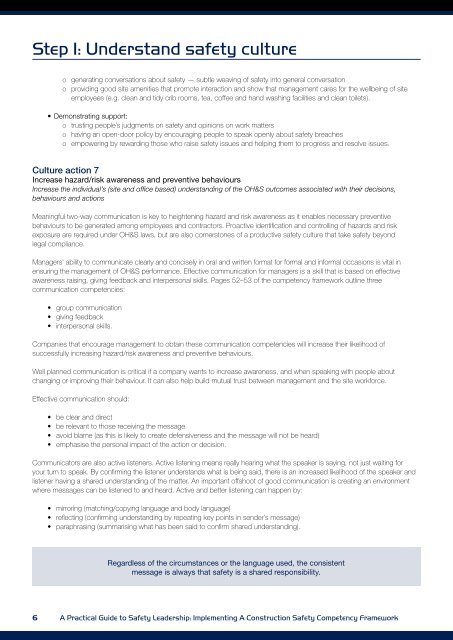A Practical Guide to Safety Leadership Book (PDF 5MB) - QUT ePrints
A Practical Guide to Safety Leadership Book (PDF 5MB) - QUT ePrints
A Practical Guide to Safety Leadership Book (PDF 5MB) - QUT ePrints
You also want an ePaper? Increase the reach of your titles
YUMPU automatically turns print PDFs into web optimized ePapers that Google loves.
Step 1: Understand safety culture<br />
o generating conversations about safety — subtle weaving of safety in<strong>to</strong> general conversation<br />
o providing good site amenities that promote interaction and show that management cares for the wellbeing of site<br />
employees (e.g. clean and tidy crib rooms, tea, coffee and hand washing facilities and clean <strong>to</strong>ilets).<br />
• Demonstrating support:<br />
o trusting people’s judgments on safety and opinions on work matters<br />
o having an open-door policy by encouraging people <strong>to</strong> speak openly about safety breaches<br />
o empowering by rewarding those who raise safety issues and helping them <strong>to</strong> progress and resolve issues.<br />
Culture action 7<br />
Increase hazard/risk awareness and preventive behaviours<br />
Increase the individual’s (site and office based) understanding of the OH&S outcomes associated with their decisions,<br />
behaviours and actions<br />
Meaningful two-way communication is key <strong>to</strong> heightening hazard and risk awareness as it enables necessary preventive<br />
behaviours <strong>to</strong> be generated among employees and contrac<strong>to</strong>rs. Proactive identification and controlling of hazards and risk<br />
exposure are required under OH&S laws, but are also corners<strong>to</strong>nes of a productive safety culture that take safety beyond<br />
legal compliance.<br />
Managers’ ability <strong>to</strong> communicate clearly and concisely in oral and written format for formal and informal occasions is vital in<br />
ensuring the management of OH&S performance. Effective communication for managers is a skill that is based on effective<br />
awareness raising, giving feedback and interpersonal skills. Pages 52–53 of the competency framework outline three<br />
communication competencies:<br />
• group communication<br />
• giving feedback<br />
• interpersonal skills.<br />
Companies that encourage management <strong>to</strong> obtain these communication competencies will increase their likelihood of<br />
successfully increasing hazard/risk awareness and preventive behaviours.<br />
Well planned communication is critical if a company wants <strong>to</strong> increase awareness, and when speaking with people about<br />
changing or improving their behaviour. It can also help build mutual trust between management and the site workforce.<br />
Effective communication should:<br />
• be clear and direct<br />
• be relevant <strong>to</strong> those receiving the message<br />
• avoid blame (as this is likely <strong>to</strong> create defensiveness and the message will not be heard)<br />
• emphasise the personal impact of the action or decision.<br />
Communica<strong>to</strong>rs are also active listeners. Active listening means really hearing what the speaker is saying, not just waiting for<br />
your turn <strong>to</strong> speak. By confirming the listener understands what is being said, there is an increased likelihood of the speaker and<br />
listener having a shared understanding of the matter. An important offshoot of good communication is creating an environment<br />
where messages can be listened <strong>to</strong> and heard. Active and better listening can happen by:<br />
• mirroring (matching/copying language and body language)<br />
• reflecting (confirming understanding by repeating key points in sender’s message)<br />
• paraphrasing (summarising what has been said <strong>to</strong> confirm shared understanding).<br />
Regardless of the circumstances or the language used, the consistent<br />
message is always that safety is a shared responsibility.<br />
6 A <strong>Practical</strong> <strong>Guide</strong> <strong>to</strong> <strong>Safety</strong> <strong>Leadership</strong>: Implementing A Construction <strong>Safety</strong> Competency Framework

















